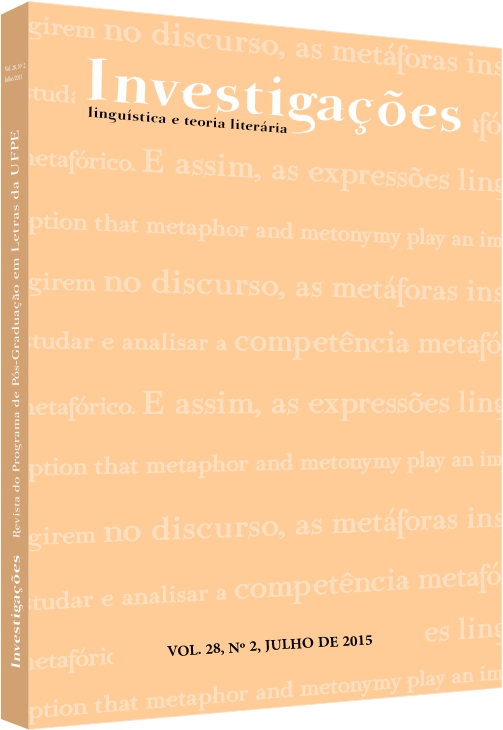Metáforas na linguagem especializada da patente de invenção
Abstract
Partindo dos pressupostos teóricos da Linguística Cognitiva, e, especificamente, da Teoria da Metáfora Conceitual, de Lakoff e Jonhson (1980, 2003), desenvolvemos um trabalho de descrição e análise dos usos metafóricos em documentos de patentes de invenção biotecnológicas europeias. Seguindo as propostas metodológicas da Linguística de Corpus, construímos um corpus de estudo com os textos de 50 patentes, a partir do qual foi possível observar como os redatores de patentes usam vários tipos de metáforas no processo descritivo e reivindicatório de uma patente de invenção.
Palavras-chave: Linguística Cognitiva. Metáfora conceitual. Linguagem especializada. Patentes de invenção.
References
ARISTÓTELES. Poética. Tradução: SOUZA, E. de. Porto Alegre: Globo, 1996.
BERBER SARDINHA, Tony. Linguística de Corpus. Baruery, SP: Editora, Manole. 2004.
BOYD, R. Metaphor and theory change: What is ‘metaphor’ a metaphor for? In: ORTONY (Ed.). Metaphor and thought. 2nd ed, Cambridge: Cambridge University Press, p. 481–533. 1993.
CAMERON, L. Metaphor and talk. In: R. W. Gibbs (Ed.), The Cambridge handbook of metaphor and thought. Cambridge etc: Cambridge University Press. 2008
______. Metaphor in educational discourse. London: Continuum. 2003.
CHARTERIS-BLACK, J. Corpus approaches to critical metaphor analysis. London: Palgrave MacMillan. 2004.
CHARTERIS-BLACK, J.; MUSOLFF, A. 'Battered Hero' or 'Innocent Victim'? A comparative study of metaphors for euro trading in British and German financial reporting. English for Specific Purposes, v. 22, p. 153-176, 2003.
FALEIRO, F.; ANDRADE, S. (eds). Biotecnologia: estado da arte e aplicações na agropecuária. Planaltina, DF: Embrapa Cerrados, 2011.
GIBBS, R. (Ed.). Cambridge handbook of metaphor and thought. New York: Cambridge University Press, 2008.
______.The poetics of mind: Figurative thought, language, and understanding. New York: Cambridge University Press, 1994.
GILES, T.D. Motives for Metaphor in Scientific and Technical Communication. Amityville, NY: Baywood Publishing, 2008. 178 p.
GOATLY, A. The language of metaphors. London: Routledge, 1997.
GODDARD, C. The ethnopragmatics and semantics of ‘active metaphors’. Journal of Pragmatics, v. 36, n.7, p. 1211-1230, 2004.
GRADY, J. Foundations of Meaning: Primary metaphors and primary scenes. 1997. 299 f. Tese (Doutorado) - University of California, Berkeley, 1997.
HUANG, Carolina. A metáfora no texto científico de medicina: um estudo terminológico da linguagem sobre AIDS. Programa de Pós-graduação em Letras. Dissertação de Mestrado. 2005.
JOHNSON, Mark. Mind, metaphor, law. Mercer Law Review. v. 58, n. 3, p. 845-868, 2007.
______. The Body in the Mind: the bodily basis of meaning, imagination, and reason. Chicago: University of Chicago Press. 1987.
KNUDSEN, S. Communicating novel and conventional scientific metaphors: a study of the development of the metaphor of genetic code. Public Understanding of Science, v. 14, n. 4, p. 373-392, 2005.
KÖVECSES, Zoltán. Metaphor: a practical introduction. 2nd ed. Nova York: Oxford, 2010. 375 p.
LAKOFF, G. The contemporary theory of metaphor. In: ORTONY, A. (Ed). Metaphor and thought. 2nd ed. Cambridge: Cambridge University Press, 1993.
______. Women, Fire and Dangerous Things: What Categories Reveal about the Mind. Chicago: University of Chicago Press, 1987.
LAKOFF, G.; JOHNSON, M. 2nd ed. Metaphors we live by. Chicago: Chicago University Press, 2003.
______. Metaphors we live by. Chicago: Chicago University Press, 1980.
______. Philosophy in the flesh: The embodied mind and its challenge to western thought. New York: Basic Books, 1999. 508 p. Versão digital.
LIMA, P. L. C. A nova tipologia da metáfora conceitual. Revista de Humanidades e Ciências Sociais da Uece, Fortaleza, v. 5, n. 2, p. 17-26, 2003.
REDDY, M. J. The conduit metaphor- a case of frame conflict in our language about language. In A. Ortony (ed.), Metaphor and Thought. Cambridge, England: Cambridge University Press, p. 284-324, 1979.
SHEN, Y.; BALABAN, N. Metaphorical (in)coherence in discourse. Discourse Processes, v. 28, n.2, p. 139-154, 1999.
STEEN, G. The contemporary theory of metaphor -- now new and improved! Review of Cognitive Linguistics, v. 9, n.1, p. 26-64, 2011a.
______. From three dimensions to five steps: The value of deliberate metaphor. Metaphorik.de, v. 21, 2011b.
______. What does ‘really deliberate’ really mean? More thoughts on metaphor and consciousness. Metaphor and Social World, v. 1, n. 1, p. 53-56, 2011c.
______. The paradox of metaphor: Why we need a three-dimensional model of metaphor. Metaphor and Symbol, v. 23, n. 4, p. 213-241. 2008.
______. When is metaphor deliberate? In N.-L. Johannesson, C. Alm-Arvius, & D. Minugh (Eds.), Selected Papers from the Stockholm 2008 Metaphor Festival, p. 43-63, 2010.
TEMMERMAN, R. Towards New Ways of Terminology Description: The Sociocognitive Approach. Amsterdam/Philadelphia: John Benjamins, 2000.
Downloads
Published
How to Cite
Issue
Section
License
Copyright (c) 2015 Jessé de Sousa Mourão, Paula Lenz Costa Lima

This work is licensed under a Creative Commons Attribution 4.0 International License.
Authors who publish with Revista Investigações agree to the following terms:
Authors retain copyright and grant the journal right of first publication with the work simultaneously licensed under the Creative Commons Attribution 4.0 International (CC BY 4.0) license that allows others to share the work with an acknowledgement of the work's authorship and initial publication in this journal.
Authors are able to enter into separate, additional contractual arrangements for the non-exclusive distribution of the journal's published version of the work (e.g., post it to an institutional repository or publish it in a book), with an acknowledgement of its initial publication in this journal.
You are free to:
Share — copy and redistribute the material in any medium or format for any purpose, even commercially.
Adapt — remix, transform, and build upon the material for any purpose, even commercially.
The licensor cannot revoke these freedoms as long as you follow the license terms.
Under the following terms:
Attribution — You must give appropriate credit , provide a link to the license, and indicate if changes were made . You may do so in any reasonable manner, but not in any way that suggests the licensor endorses you or your use.
No additional restrictions — You may not apply legal terms or technological measures that legally restrict others from doing anything the license permits.

